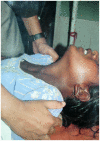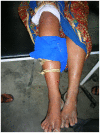Snake bite in South Asia: a review
- PMID: 20126271
- PMCID: PMC2811174
- DOI: 10.1371/journal.pntd.0000603
Snake bite in South Asia: a review
Abstract
Snake bite is one of the most neglected public health issues in poor rural communities living in the tropics. Because of serious misreporting, the true worldwide burden of snake bite is not known. South Asia is the world's most heavily affected region, due to its high population density, widespread agricultural activities, numerous venomous snake species and lack of functional snake bite control programs. Despite increasing knowledge of snake venoms' composition and mode of action, good understanding of clinical features of envenoming and sufficient production of antivenom by Indian manufacturers, snake bite management remains unsatisfactory in this region. Field diagnostic tests for snake species identification do not exist and treatment mainly relies on the administration of antivenoms that do not cover all of the important venomous snakes of the region. Care-givers need better training and supervision, and national guidelines should be fed by evidence-based data generated by well-designed research studies. Poorly informed rural populations often apply inappropriate first-aid measures and vital time is lost before the victim is transported to a treatment centre, where cost of treatment can constitute an additional hurdle. The deficiency of snake bite management in South Asia is multi-causal and requires joint collaborative efforts from researchers, antivenom manufacturers, policy makers, public health authorities and international funders.
Conflict of interest statement
The authors have declared that no competing interests exist.
Figures



References
-
- Simpson ID, Norris RL. The global snakebite crisis–a public health issue misunderstood, not neglected. Wilderness Environ Med. 2009;20:43–56. - PubMed
-
- Ali Z. Snake bite: a medical and public health problem in Pakistan. In: Gopalakrishnakone P, Chou LM, editors. Snakes of medical importance (Asia Pacific region) Singapore. National University Singapore; 1990. pp. 447–461.
Publication types
MeSH terms
Substances
Grants and funding
LinkOut - more resources
Full Text Sources
Other Literature Sources

